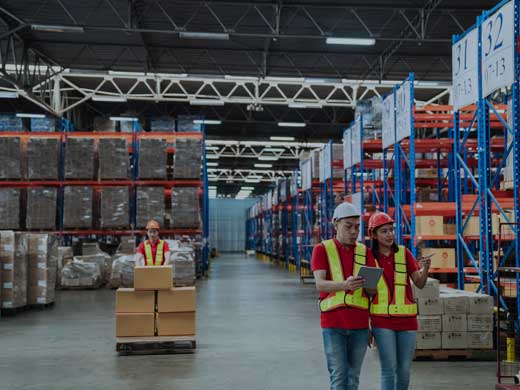Food and beverage businesses that want to stay healthy for the long term need to monitor their vital signs in real time.
Just as health-conscious individuals track the number of steps they take in a day or the heartbeats per minute of a workout, your business benefits in critical ways by monitoring your vital signs, or Key Performance Indicators (KPIs), in real time. KPIs enable you to do the following:
1) Track progress toward goals
When aligned with your business goals, KPIs tell you how you’re progressing toward these goals.
Let’s say your goal is to increase how much quality product you produce (i.e., throughput). By monitoring the right KPIs in real time, you could observe current data, compare it to past periods, and evaluate how your business was progressing.
2) Gain insight into problems
By analyzing the data of your KPIs, you can gain business insights. Let’s say you notice that your food waste increases when you use a component from vendor X. Or, perhaps you find that extreme weather conditions reduce the efficiency of your production equipment. When the right KPIs are being tracked, you can analyze your data, observe when and where these phenomena occur, and take proactive corrective action.
3) Compare your business to industry benchmarks
Tracking your KPIs can also help you gauge how you’re doing compared to industry benchmarks. For example, if your gross profit margin is about X% and the industry benchmark is Y%, this information lets you know where to allocate your resources for improvement.
So given the critical importance of KPIs for long-term success, why is it that many food and beverage businesses still do not use them to guide their business decisions, reduce waste, and enhance productivity and profitability?
Why data collection is challenging for some SMEs
Too many business leaders simply make do with their current reporting methods without fully realizing the risks they may be exposing their growing businesses to.
For example, inventory or production data may be distributed in different business functions in various spreadsheets, basic accounting programs, or even paper reports. These data sources don’t communicate with each other. They’re updated at intervals, some of which may coincide with accounting cut-offs. But when a decision-maker needs a report fast, they’re not getting a real-time snapshot of operations. Rather, they’re evaluating a reflection of the business as captured at the last entry of data, which may be days old.
Furthermore, they’re looking at data that may have been manually entered more than once by several members of the team. Consider all the time spent on those multiple entries of identical data, and how much human error may have polluted the entire process.
Fortunately, there’s a better way to collect data and get real-time reporting to support productivity and profitability.
How to connect to real-time data and KPIs
Enterprise Resource Planning (ERP) software standardizes and centralizes all the data of your business functions in one database, and updates it in real time whenever new information is input. So, you’re always accessing the absolute latest data about your business. If you’re working with the right ERP system, you can self-customize your KPIs per business function and assemble them in dashboards that will give you at a glance the status of your business at that very moment.
To get to that advantageous position for your food and beverage business, your team will need to invest some time in defining all your work processes and implementing the ERP system. An experienced ERP vendor can guide you through that process and also train your people in how to work effectively with the ERP.
If the thought of making such an investment gives you pause, consider the cost of not making it. As your business grows in volume and complexity, your need for reliable data in real-time will grow with you, as will the impact of the decisions made from your data. Can you afford not to make this investment?
How to work with KPIs
Once your ERP system is in place, you’ll find that you have a wide range of KPIs you can customize to help guide your decision-making. So what’s the most productive approach to working with KPIs? Our suggestions follow:
1) Focus on a handful.
Follow the KPIs tied directly to the goals of your business plan. This way, you’ll keep your focus on measuring your progress and making decisions that are most relevant to your goals.
2) Keep your KPIs in perspective
Don’t make the mistake of being overly focused on one KPI. If, for example, you’re focusing on maintaining high throughput, you also need to keep an eye on your levels of food waste in production, the rejects in quality control, and the downtime of your hard-working production equipment. Without this balanced perspective on several KPIs, your pursuit of throughput will hurt you in costly waste and lost production time.
3) Track your KPIs over time
With a history of metrics to evaluate, you’ll gain greater insight into your business performance and the factors contributing to it.
4) Group KPIs in dashboards
With the right ERP, your KPIs can be conveniently grouped in dashboards. Each business function can have its own set of KPIs to keep every one of your individual teams informed on how they’re doing.
Which KPIs will help enhance your productivity and profitability?
For food and beverage manufacturers and processors, some KPIs are golden. Consider these five.
KPI #1: Waste
Because your business uses perishable raw materials, you have to watch closely how much of it is being lost due to the following factors:
- Spoilage due to storage beyond expiry date
- Food waste inevitably resulting from production processes
- Rejection by quality control.
KPI #2: Variances in raw material costs
You may have forecast a one-dollar cost for item X, but it actually arrived at your warehouse at $1.13. You need to stay on top of all of your raw material variances to ensure that your pricing still makes sense at the end of the day.
KPI #3: Variances in production costs
Just as with your raw material costs, your production costs may fluctuate compared to what you’ve budgeted. Your ERP enables you to analyze your production costs at a granular level, every day, at any time, allowing you to analyze these fluctuations and gain insight into the factors driving them.
KPI #4: Yield per product line
Yield is the percentage of your output for product X that is made to standard, without being reworked or scrapped. If you’re manufacturing 100 units of X, but only 86% is shippable and the industry benchmark is 94%, then you may want to take a closer look at how you’re making the product.
Your yield also impacts the actual value of a product line, which may vary from the value you estimated. In your analysis of these variances, you may find, for example, that particular suppliers contribute to, or diminish, the yield of your product.
KPI #5: Margin per product, per customer, per day
What is your operating margin per product X? It’s the profit you’ve made on X after paying for its variable costs of production, such as labour and raw materials, but before you’ve paid interest and taxes.
By tracking this KPI, you can literally monitor every dollar of profit you make on every product for any customer at any time. Knowing your operating margin also provides you with a useful benchmark when comparing your business to others in your sector.
The benefits of closely monitoring your golden KPIs
In the competitive food and beverage market, margins are traditionally low. By keeping your five golden KPIs in daily sight, you’ll be able to do the following:
- Follow your production throughput in real time and adapt it according to customer demand.
- Limit waste and plan your purchasing better.
- Minimize losses stemming from production downtime due to equipment failure through overuse. (You may be pushing production too hard in making up for prior delays and, as a result, neglect preventive maintenance).
For any food and beverage business, and especially a growing one, tracking your KPIs is essential to long-term success. By choosing the right KPIs to monitor and analyzing their data regularly, you’ll be able to enhance your decision-making and build a more productive and profitable business.
If you have more questions, do reach out to us.





